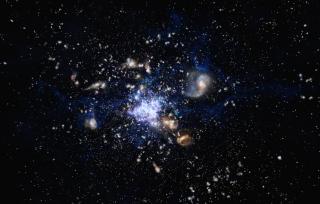Bibcode
Frias Castillo, Marta; Hodge, Jacqueline; Rybak, Matus; van der Werf, Paul; Smail, Ian; Birkin, Jack E.; Chen, Chian-Chou; Chapman, Scott C.; Hill, Ryley; Lagos, Claudia del P.; Liao, Cheng-Lin; da Cunha, Elisabete; Calistro Rivera, Gabriela; Chen, Jianhang; Jiménez-Andrade, E. F.; Murphy, Eric J.; Scott, Douglas; Swinbank, A. M.; Walter, Fabian; Ivison, R. J.; Dannerbauer, Helmut
Referencia bibliográfica
The Astrophysical Journal
Fecha de publicación:
3
2023
Revista
Número de citas
28
Número de citas referidas
24
Descripción
We present the initial results of an ongoing survey with the Karl G. Jansky Very Large Array targeting the CO(J = 1-0) transition in a sample of 30 submillimeter-selected, dusty star-forming galaxies (SFGs) at z = 2-5 with existing mid-J CO detections from the Atacama Large Millimeter/submillimeter Array and NOrthern Extended Millimeter Array, of which 17 have been fully observed. We detect CO(1-0) emission in 11 targets, along with three tentative (~1.5σ-2σ) detections; three galaxies are undetected. Our results yield total molecular gas masses of 6-23 × 1010 (α CO/1) M ⊙, with gas mass fractions, f gas = M mol/(M *+M mol), of 0.1-0.8 and a median depletion time of (140 ± 70) Myr. We find median CO excitation ratios of r 31 = 0.75 ± 0.39 and r 41 = 0.63 ± 0.44, with significant scatter. We find no significant correlation between the excitation ratio and a number of key parameters such as redshift, CO(1-0) line width, or ΣSFR. We only find a tentative positive correlation between r 41 and the star-forming efficiency, but we are limited by our small sample size. Finally, we compare our results to predictions from the SHARK semi-analytical model, finding a good agreement between the molecular gas masses, depletion times, and gas fractions of our sources and their SHARK counterparts. Our results highlight the heterogeneous nature of the most massive SFGs at high redshift, and the importance of CO(1-0) observations to robustly constrain their total molecular gas content and interstellar medium properties.
Proyectos relacionados

Gas Molecular y Polvo en Galacias através del Tiempo Cósmico
Dos cuestiones fundamentales en la Astrofísica son la conversión de gas molecuar en estrellas y cómo este proceso físico depende del entorno en todas las escalas, desde sistemas planetarios, cúmulos estelares, galaxias hasta cúmulos de galaxias. El objectivo principal de este proyecto es el de estudiar la formación y evolución de galaxias a partir
Helmut
Dannerbauer